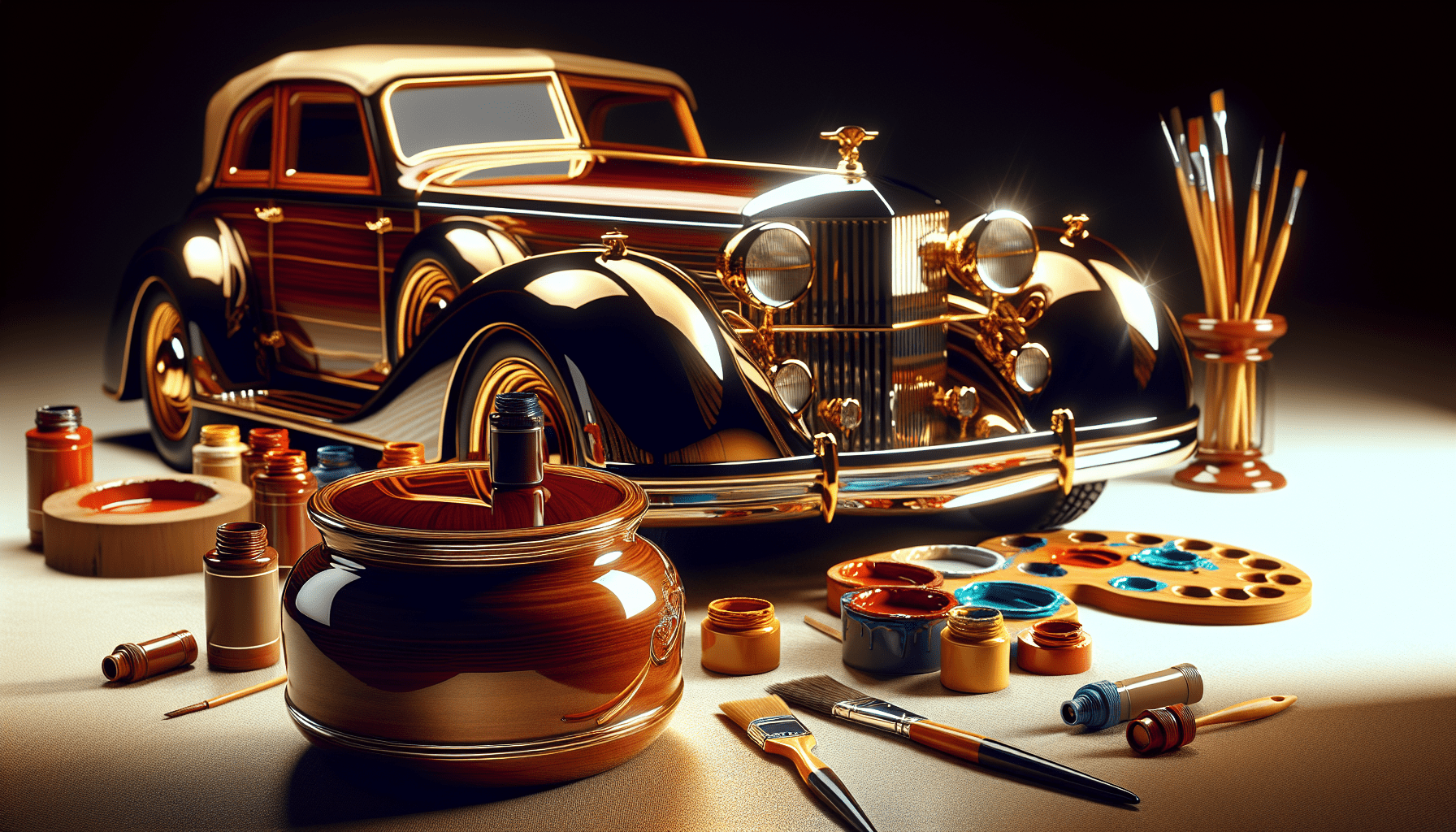Clear coating over enamel paint is a common concern for many individuals in the automotive and DIY world. The question arises, can you achieve a flawless and durable finish by applying a clear coat over enamel paint? This article will explore the compatibility and potential challenges that may arise when attempting to clear coat over enamel paint, providing you with the essential information needed for a successful and professional-looking project.

What is Enamel Paint?
Definition of Enamel Paint
Enamel paint is a type of paint that is known for its hard, glossy finish. It is composed of a resin that dries to a smooth and durable surface. Enamel paint is named for its resemblance to the finish of fired enamel, although it does not contain any actual enamel. It is often used for surfaces that require a high level of durability and protection.
Properties of Enamel Paint
Enamel paint has several key properties that make it a popular choice for various applications. Firstly, it is known for its excellent adhesion, allowing it to bond well with different surfaces such as metal, wood, and glass. Additionally, enamel paint is highly resistant to water, chemicals, and abrasion, making it suitable for both indoor and outdoor use. It also provides a rich, lustrous finish that adds visual appeal to any project.
Common Uses of Enamel Paint
Enamel paint is used in a wide range of applications due to its durability and versatility. Some common uses include:
- Automobiles: Enamel paint is commonly used for automotive finishes, providing a glossy and protective layer over the vehicle’s surface.
- Home Decor: It is popular for painting furniture, cabinets, and trim, as it offers a smooth and long-lasting finish.
- Industrial Applications: Enamel paint is often utilized in industrial settings to protect machinery, equipment, and metal surfaces from corrosion and wear.
- Arts and Crafts: Many artists and craftsmen use enamel paint for their creations due to its vibrant colors and durability.
What is Clear Coat?
Definition of Clear Coat
Clear coat, also known as a topcoat or clear finish, is a transparent layer applied over a painted surface to provide additional protection and enhance its appearance. It is typically made from a clear resin that forms a hard and transparent film when it dries. Clear coat is used to add gloss, shine, and durability to painted surfaces.
Purpose of Clear Coat
The primary purpose of clear coat is to protect the underlying paint from damage caused by exposure to the elements, such as UV radiation, moisture, and physical abrasion. It acts as a shield, preventing the paint from fading, chipping, or peeling. Additionally, clear coat adds depth and luster to the painted surface, creating a smooth and reflective finish.
Benefits of Clear Coat
Using a clear coat over painted surfaces provides several benefits. These include:
- Protection: Clear coat offers an extra layer of protection against scratches, weathering, and fading, ensuring that the paint stays vibrant and intact for an extended period.
- Enhanced Appearance: Clear coat adds depth, gloss, and shine to the painted surface, making it look more attractive and professional.
- Ease of Maintenance: A clear-coated surface is easier to clean and maintain than bare paint, as it is less susceptible to staining and dirt accumulation.
Compatibility of Clear Coat and Enamel Paint
Can You Clear Coat Over Enamel Paint?
Yes, it is indeed possible to apply a clear coat over enamel paint. In fact, using a clear coat can further enhance the durability, gloss, and protection of enamel paint. It creates an additional barrier that helps guard the underlying paint layer.
Factors to Consider
Before applying a clear coat over enamel paint, there are some crucial factors to consider to ensure compatibility and optimal results:
- Curing Time: Enamel paint requires sufficient curing time before applying a clear coat. Consult the manufacturer’s instructions for the specific time frame required.
- Compatibility: Ensure that the clear coat you intend to use is compatible with the type of enamel paint. Different clear coats are designed for specific types of paint, so it is essential to choose the right one.
- Surface Preparation: Properly prepare the enamel paint surface by cleaning it thoroughly and removing any contaminants such as dust, grease, or wax. This will ensure good adhesion of the clear coat.
Preparation Steps
To prepare the enamel paint surface for clear coating, follow these steps:
- Clean the Surface: Wash the painted surface with soap and water to remove any dirt, dust, or oil residues. Rinse thoroughly and allow the surface to dry completely.
- Smooth out Imperfections: If there are any imperfections on the enamel paint surface, such as bumps or rough areas, sand them gently using a fine-grit sandpaper. This will create a smooth and even surface for the clear coat.
- Remove Wax or Silicone: If the enamel paint has been previously waxed or treated with silicone-based products, remove them using a wax and grease remover. Such substances can hinder the adhesion of the clear coat.
- Mask Off Surrounding Areas: Use painter’s tape and plastic sheeting to mask off any areas that should not be clear coated, such as trim or windows. This will prevent overspray and ensure a clean finish.
Applying Clear Coat Over Enamel Paint
Steps to Follow
To apply a clear coat over enamel paint, follow these steps:
- Choose a Well-Ventilated Area: Ensure that you are working in a well-ventilated space to avoid inhaling fumes or overspray. If necessary, wear a respirator or mask for added safety.
- Shake the Clear Coat: Thoroughly shake the can of clear coat to mix the contents and ensure a consistent finish.
- Apply a Thin Coat: Hold the can approximately 12-18 inches away from the surface and spray a thin and even coat of clear coat. Begin spraying off the surface and move in a steady back-and-forth motion.
- Allow to Dry: Let the first coat dry as per the manufacturer’s instructions. Typically, this requires several hours, but consult the product label for precise drying times.
- Apply Additional Coats: Apply additional coats of clear coat, allowing sufficient drying time between each coat, until you achieve the desired level of gloss and protection.
- Final Cure: After the last coat, allow the clear coat to cure fully. This can take several days or longer, depending on the specific product and environmental conditions.
Recommended Techniques
To achieve the best results when applying a clear coat over enamel paint, consider the following techniques:
- Light and Even Spraying: Ensure that you spray the clear coat evenly and in a light manner. This will prevent runs, drips, or uneven glossiness.
- Overlapping Strokes: When applying the clear coat, slightly overlap each stroke with the previous one. This will help achieve a consistent and seamless finish.
- Multiple Thin Coats: Rather than applying one thick coat, it is recommended to use multiple thin coats. This allows for better control and reduces the risks of imperfections.
Common Mistakes to Avoid
When clear coating enamel paint, it is important to avoid the following common mistakes:
- Applying Too Thick: Applying a thick coat of clear coat can result in runs, drips, or an uneven finish. Stick to thin coats to achieve a smooth and professional outcome.
- Skipping Surface Preparation: Failing to properly clean and prepare the enamel paint surface can lead to poor adhesion and reduced durability of the clear coat.
- Ignoring Curing Time: Rushing the process by applying clear coat before the enamel paint has fully cured can lead to negative outcomes, such as bubbles or blushing in the finish.
- Poor Spray Technique: Inconsistent spraying techniques, such as holding the can too close or spraying too quickly, can result in an uneven and unattractive finish.

Benefits of Clear Coating Enamel Paint
Enhanced Durability
Clear coating enamel paint enhances its durability by providing an additional layer of protection against scratches, abrasion, and weathering. It helps the paint withstand the harsh elements and everyday wear and tear, ensuring a longer lifespan.
Increased Gloss and Shine
The application of a clear coat over enamel paint adds depth, gloss, and shine to the painted surface. This enhanced visual appearance creates a more professional and refined finish, making it ideal for projects that require a high-quality aesthetic.
Improved Protection
Clear coat acts as a barrier against harmful environmental factors such as UV radiation, moisture, and chemicals, which can degrade the enamel paint. By acting as a protective shield, it prevents color fading, chipping, and other forms of damage, thereby prolonging the life of the paint.
Potential Issues and Solutions
Yellowing of Clear Coat
In some cases, the clear coat may develop a yellow tint over time, especially when exposed to sunlight. To prevent or alleviate yellowing, consider using a clear coat specifically designed to resist yellowing or one with UV protection. Regular cleaning and maintenance can also help preserve the clarity of the clear coat.
Orange Peel Effect
Occasionally, the clear coat may dry with a textured or orange peel-like appearance. This can occur due to improper spraying techniques, excessive coats, or environmental conditions. To address this issue, lightly sand the affected areas with fine-grit sandpaper and apply a new coat using proper spraying techniques.
Peeling or Chipping
In rare cases, the clear coat may peel or chip, indicating poor adhesion to the enamel paint. This can be caused by inadequate surface preparation or incompatible products. To resolve this issue, remove the peeling or chipped clear coat, properly clean and prepare the surface, and reapply a new coat of clear coat following the recommended techniques.
Alternate Options to Clear Coating Enamel Paint
Waxing or Polishing
An alternative to clear coating enamel paint is to apply a layer of wax or polish over the painted surface. Waxing or polishing can enhance the shine and offer some protection against minor scratches and UV radiation. However, it may not provide the same level of durability and long-lasting protection as a clear coat.
Using Varnish
Another option is to use a varnish specifically formulated for enamel paint. Varnish provides a protective layer over the paint and offers increased durability. However, it is important to choose a varnish that is compatible with enamel paint to achieve optimal results.
Choosing Satin or Gloss Finish
Instead of applying a clear coat, selecting enamel paint with a satin or gloss finish can provide enhanced durability and aesthetic appeal. Satin and gloss finishes offer inherent protection and a smooth, shiny surface without the need for an additional clear coat.
Tips for Maintaining Clear Coated Enamel Paint
Regular Cleaning and Maintenance
To keep clear coated enamel paint in optimal condition, regular cleaning and maintenance are essential. Use a mild soap or automotive cleaner and a soft cloth to gently clean the painted surface. Avoid using abrasive cleaners or scrub brushes that could damage the clear coat.
Avoiding Harsh Chemicals
To prevent damage to the clear coat, avoid using harsh chemicals or solvents on the painted surface. Certain cleaning agents, gasoline, or brake fluid can deteriorate the clear coat and cause it to peel or become discolored. Always read and follow the manufacturer’s recommendations for cleaning and maintenance.
Repairing Damaged Clear Coats
If the clear coat on the enamel paint becomes damaged or develops imperfections such as scratches or chips, it can be repaired. Lightly sand the damaged area with fine-grit sandpaper, feathering the edges to ensure a smooth transition. Then, clean the surface and reapply a new coat of clear coat following the recommended application techniques.
Conclusion
Clear coating over enamel paint can provide numerous benefits, including enhanced durability, increased gloss and shine, and improved protection. While ensuring proper surface preparation and using compatible products are essential for achieving optimal results, clear coat can significantly enhance the appearance and longevity of enamel paint. Whether for automotive finishes, home decor, or industrial applications, clear coating offers a reliable method of enhancing and protecting enamel paint surfaces.
References
[1] “Enamel Paint: Properties and Benefits,” OurProperty.co.uk. [2] “What Clear Coat over Enamel Paint,” scaleautomag.com. [3] “How to Apply Clear Coat 2021: Steps, Techniques, and Tips,” CarCareHunt.com.



